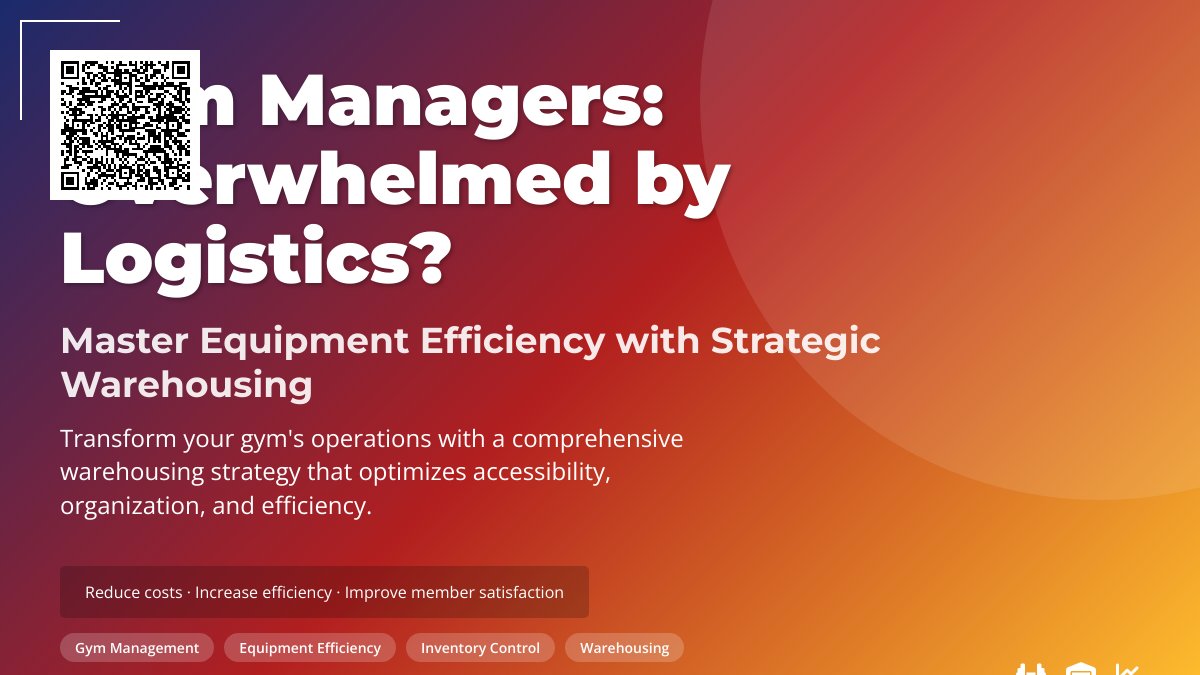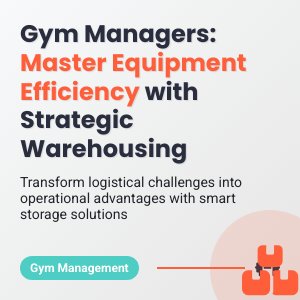Abstract: 你写的摘要内容:
Gym management often involves a complex logistical challenge, particularly when it comes to efficiently managing equipment and supplies. This article, “Gym Managers: Overwhelmed by Logistics? Always Need Equipment Efficiently – The Secret: Strategic Warehousing,” addresses this common pain point, arguing that a well-planned warehousing strategy is key to improving gym operations. It identifies frequent logistical headaches – including lost equipment, inefficient inventory, and equipment downtime – and proposes a solution: strategic warehousing. This approach involves dedicated storage zones, categorized and labeled equipment, accessible layouts, and a robust inventory management system. The benefits include increased efficiency, reduced costs, improved member satisfaction, and enhanced safety. The article outlines practical steps for implementation, from initial assessment and planning to advanced strategies like just-in-time inventory and preventative maintenance. Ultimately, strategic warehousing transforms logistical challenges into a competitive advantage, allowing gyms to optimize space, streamline maintenance, and make data-driven decisions. By investing in this approach, gym managers can unlock their facility’s full potential and deliver a superior member experience.
---
Gym Managers: Overwhelmed by Logistics? Master Equipment Efficiency with Strategic Warehousing
Gym management is a multifaceted challenge. Beyond the motivational instructors, engaging classes, and committed members lies a logistical maze that can easily overwhelm even the most experienced manager. From tracking inventory and maintaining equipment to optimizing space and handling repairs, the demands are constant. At the heart of these challenges lies the critical need for efficient equipment access. If your trainers can't quickly locate the right tools, your maintenance team can't find replacement parts, or your storage area is a disorganized mess, your gym's operations will suffer. The solution to these challenges? Strategic warehousing.
This article delves into the common logistical hurdles faced by gym managers and explores how a well-planned warehousing strategy can enhance efficiency, reduce costs, and elevate the member experience.
The Weight of the Problem: Common Logistical Challenges in Gyms
Let's face it—many gym managers spend too much time on issues that should be easily manageable. Here are some of the most prevalent problems:
- Lost or Misplaced Equipment: How often have your trainers spent valuable class time searching for specific equipment? This not only wastes time but also frustrates members and disrupts gym operations.
- Inefficient Inventory Management: Knowing exactly what you have, where it is, and when to reorder is crucial. Without a reliable system, you risk overstocking (tying up capital) or understocking (disappointing members).
- Downtime Due to Equipment Repairs: Broken equipment is a major source of frustration. Quick access to spare parts and tools is essential to minimize downtime and keep your gym running smoothly.
- Space Constraints and Clutter: Gyms are often packed with equipment. Poor organization leads to wasted space, safety hazards, and an unappealing environment.
- Difficulties with Equipment Rotation and Maintenance: Regular maintenance and rotation are vital for equipment longevity and safety. A disorganized warehouse makes these tasks significantly more challenging.
- Difficulty Tracking Equipment Lifecycle: Knowing when equipment is nearing the end of its lifespan is key for budgeting and planning replacements. Lack of tracking leads to unexpected and costly replacements.
- Increased Labor Costs: Searching for equipment, manually tracking inventory, and inefficient maintenance all contribute to higher labor costs.
These issues aren't just minor inconveniences; they directly impact your bottom line, member satisfaction, and operational efficiency.
What is Strategic Warehousing for Gyms?
Strategic warehousing isn't just about having a storage room. It's a comprehensive approach to managing your gym’s equipment and supplies to optimize accessibility, organization, and efficiency. Key components include:
- Dedicated Storage Zones: Clearly defined areas for different equipment types, such as cardio machines, strength training tools, free weights, accessories, and maintenance supplies.
- Categorization and Labeling: A robust system for categorizing and labeling all equipment and parts. This could involve color-coding, barcode scanning, or a digital inventory management system.
- Accessibility and Layout: Arranging equipment and supplies for easy access, considering frequency of use and maintenance needs. Frequently used items should be readily available.
- Inventory Management System (IMS): Implementing a system (manual or digital) to track inventory levels, usage patterns, and maintenance schedules.
- Regular Audits and Organization: Periodic checks to ensure the warehouse remains organized and inventory is accurate.
- Safety Protocols: Ensuring the warehouse is safe, with clear pathways, proper ventilation, and appropriate storage for hazardous materials like cleaning supplies and lubricants.
The Benefits of Strategic Warehousing: A Return on Investment
Investing in strategic warehousing delivers tangible benefits that far outweigh the initial effort:
- Increased Efficiency: Staff can quickly locate and retrieve equipment, reducing downtime and improving service delivery.
- Reduced Costs: Minimized labor costs, reduced equipment downtime, and optimized inventory levels contribute to significant cost savings.
- Improved Member Satisfaction: Faster service, readily available equipment, and a well-maintained gym environment lead to happier members.
- Enhanced Safety: A well-organized warehouse reduces the risk of accidents and injuries.
- Better Equipment Longevity: Proper storage and maintenance practices extend the lifespan of your equipment.
- Streamlined Maintenance: Easy access to spare parts and tools enables quicker repairs and minimizes downtime.
- Data-Driven Decision Making: An IMS provides valuable insights into equipment usage, maintenance needs, and inventory levels, enabling informed decisions about purchasing and replacement.
- Improved Space Utilization: Optimized layout and storage solutions maximize the use of available space.
Key Elements of a Successful Gym Warehousing Strategy
Implementing a strategic warehousing approach involves several practical steps:
-
Assessment and Planning:
- Analyze Current Processes: Identify pain points and inefficiencies in your current equipment management system.
- Define Storage Needs: Determine the types and quantities of equipment and supplies you need to store.
- Allocate Space: Designate a dedicated warehousing area, considering size, accessibility, and potential for expansion.
- Budget: Allocate resources for storage solutions, inventory management software (if applicable), and training.
-
Organization and Layout:
- Zone Your Warehouse: Create distinct zones for different equipment categories.
- Utilize Vertical Storage: Maximize space with shelving, racking, and vertical storage solutions.
- Clear Pathways: Ensure ample space for movement and equipment handling.
- Ergonomics: Design the layout to minimize strain and fatigue for staff.
-
Inventory Management:
- Choose an IMS: Select a system that meets your needs and budget. Options range from simple spreadsheets to sophisticated software solutions. Consider barcode scanning for increased accuracy.
- Implement a Tracking System: Assign unique identifiers to each piece of equipment and track its location, usage, and maintenance history.
- Regular Inventory Audits: Conduct periodic audits to verify inventory accuracy and identify discrepancies.
-
Maintenance and Repair:
- Designated Repair Area: Create a dedicated space for equipment repairs.
- Organized Spare Parts Storage: Store spare parts in a clearly labeled and easily accessible location.
- Maintenance Schedules: Establish and adhere to regular maintenance schedules.
-
Technology Integration:
- Barcode Scanners: Speed up inventory tracking and reduce errors.
- RFID Tags: Offer advanced tracking capabilities.
- Cloud-Based IMS: Provide real-time visibility into inventory levels and equipment status from anywhere.
- Gym Management Software Integration: Integrate your IMS with your gym management software for seamless data flow.
Beyond the Basics: Advanced Warehousing Strategies
Once you've established a solid foundation, consider these advanced strategies:
- Just-in-Time (JIT) Inventory: Order supplies only when needed to minimize storage costs and reduce waste. This requires strong supplier relationships.
- Consignment Inventory: Work with suppliers to store equipment on consignment, paying only for what you use.
- Preventative Maintenance Programs: Proactive maintenance reduces breakdowns and extends equipment lifespan.
- Data Analytics: Use data from your IMS to identify trends, optimize inventory levels, and improve operational efficiency.
Conclusion: Unlock Your Gym's Potential with Strategic Warehousing
Managing a gym is demanding, but it doesn't have to be chaotic. By embracing strategic warehousing, you can transform your logistical challenges into a competitive advantage. Improved efficiency, reduced costs, enhanced member satisfaction, and a safer, more organized environment are all within reach. Don't let equipment logistics hold your gym back—invest in strategic warehousing and unlock your gym’s full potential.
Suggested Keywords (for SEO):
- Gym Management
- Gym Logistics
- Equipment Management
- Warehousing for Gyms
- Inventory Management for Gyms
- Gym Equipment Storage
- Fitness Equipment Logistics
- Gym Maintenance
- Equipment Downtime
- Gym Efficiency
- Space Optimization
- Gym Inventory Tracking System
- Gym Operations
- Fitness Center Management
- Strategic Warehousing
- Gym Equipment Repair
- Gym Storage Solutions
Important Notes (Please Read Before Publishing):
- Localization: This article is generic. Tailor it to your specific audience. Mention local gym equipment suppliers or relevant regulations.
- Images/Videos: Include high-quality images and/or videos. Show examples of well-organized gym warehouses, storage solutions, and inventory management systems. Visuals are essential for SEO and engagement.
- Internal Linking: Link to other relevant articles on your website.
- External Linking: Link to reputable sources (industry associations, equipment manufacturers, etc.).
- Readability: Use short paragraphs, bullet points, and headings to improve readability.
- Keyword Density: While keywords are included, avoid stuffing them unnaturally. Focus on writing naturally and incorporating keywords where they fit organically.
- Call to Action: Add a clear call to action at the end. Examples: "Contact us for a free consultation," "Download our guide to gym warehousing," "Learn more about our inventory management software."
- Meta Description: Write a compelling meta description (around 150-160 characters) that summarizes the article and includes relevant keywords.
- Schema Markup: Consider adding schema markup to your page to help search engines understand the content.
- Mobile-Friendliness: Ensure your website and article are mobile-friendly.
- Update Regularly: Keep the article updated with the latest trends and best practices in gym warehousing.
- Check for Accuracy: Verify all facts and figures before publishing.
- Target Audience: Adjust the language and complexity accordingly based on whether you're targeting small, independent gyms or large fitness chains.
- Case Study: Adding a brief case study of a gym that successfully implemented strategic warehousing would significantly enhance the article's credibility.














